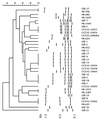Molecular characterization of Campylobacter jejuni from patients with Guillain-Barré and Miller Fisher syndromes - PubMed (original) (raw)
. 2000 Jun;38(6):2297-301.
doi: 10.1128/JCM.38.6.2297-2301.2000.
C W Ang, N van Den Braak, B Duim, A Rigter, L J Price, D L Woodward, F G Rodgers, W M Johnson, J A Wagenaar, B C Jacobs, H A Verbrugh, A van Belkum
Affiliations
- PMID: 10834992
- PMCID: PMC86786
- DOI: 10.1128/JCM.38.6.2297-2301.2000
Molecular characterization of Campylobacter jejuni from patients with Guillain-Barré and Miller Fisher syndromes
H P Endtz et al. J Clin Microbiol. 2000 Jun.
Abstract
Campylobacter jejuni has been identified as the predominant cause of antecedent infection in Guillain-Barré syndrome (GBS) and Miller Fisher syndrome (MFS). The risk of developing GBS or MFS may be higher after infection with specific C. jejuni types. To investigate the putative clonality, 18 GBS- or MFS-related C. jejuni strains from The Netherlands and Belgium and 17 control strains were analyzed by serotyping (Penner and Lior), restriction fragment length polymorphism analysis of PCR products of the flaA gene, amplified fragment length polymorphism analysis, pulsed-field gel electrophoresis, and randomly amplified polymorphic DNA analysis. Serotyping revealed 10 different O serotypes and 7 different Lior serotypes, thereby indicating a lack of serotype clustering. Two new O serotypes, O:35 and O:13/65, not previously associated with GBS or MFS were found. Serotype O:19 was encountered in 2 of 18 strains, and none was of serotype O:41. The results of all genotypic methods also demonstrated substantial heterogeneity. No clustering of GBS- or MFS-related strains occurred and no molecular marker capable of separating pathogenic GBS or MFS from non-GBS- or non-MFS-related enteritis strains could be identified in this study. Sialic-acid-containing lipopolysaccharides (LPS) are thought to be involved in the triggering of GBS or MFS through molecular mimicry with gangliosides in human peripheral nerves. Therefore, further characterization of GBS- or MFS-related C. jejuni should target the genes involved in the synthesis of LPS and the incorporation of sialic acid.
Figures
FIG. 1
FlaA PCR-RFLP patterns of 18 GBS- or MFS-related Campylobacter jejuni strains, 9 enteritis control strains, and 8 Penner O serostrains. The dendrogram was constructed with band-based analysis and unweighted pair group method with averages clustering. The sizes of standard DNA fragments (in kilobase pairs) are indicated below.
Similar articles
- Identification of DNA sequence variation in Campylobacter jejuni strains associated with the Guillain-Barré syndrome by high-throughput AFLP analysis.
Godschalk PC, Bergman MP, Gorkink RF, Simons G, van den Braak N, Lastovica AJ, Endtz HP, Verbrugh HA, van Belkum A. Godschalk PC, et al. BMC Microbiol. 2006 Apr 4;6:32. doi: 10.1186/1471-2180-6-32. BMC Microbiol. 2006. PMID: 16594990 Free PMC article. - Sequence typing confirms that Campylobacter jejuni strains associated with Guillain-Barré and Miller-Fisher syndromes are of diverse genetic lineage, serotype, and flagella type.
Dingle KE, Van Den Braak N, Colles FM, Price LJ, Woodward DL, Rodgers FG, Endtz HP, Van Belkum A, Maiden MC. Dingle KE, et al. J Clin Microbiol. 2001 Sep;39(9):3346-9. doi: 10.1128/JCM.39.9.3346-3349.2001. J Clin Microbiol. 2001. PMID: 11526174 Free PMC article. - Comparative genotyping of Campylobacter jejuni strains from patients with Guillain-Barré syndrome in Bangladesh.
Islam Z, van Belkum A, Wagenaar JA, Cody AJ, de Boer AG, Tabor H, Jacobs BC, Talukder KA, Endtz HP. Islam Z, et al. PLoS One. 2009 Sep 30;4(9):e7257. doi: 10.1371/journal.pone.0007257. PLoS One. 2009. PMID: 19789649 Free PMC article.
Cited by
- Structural characterization of Campylobacter jejuni lipooligosaccharide outer cores associated with Guillain-Barre and Miller Fisher syndromes.
Godschalk PC, Kuijf ML, Li J, St Michael F, Ang CW, Jacobs BC, Karwaski MF, Brochu D, Moterassed A, Endtz HP, van Belkum A, Gilbert M. Godschalk PC, et al. Infect Immun. 2007 Mar;75(3):1245-54. doi: 10.1128/IAI.00872-06. Epub 2007 Jan 29. Infect Immun. 2007. PMID: 17261613 Free PMC article. - Identification of Campylobacter heat-stable and heat-labile antigens by combining the Penner and Lior serotyping schemes.
Woodward DL, Rodgers FG. Woodward DL, et al. J Clin Microbiol. 2002 Mar;40(3):741-5. doi: 10.1128/JCM.40.3.741-745.2002. J Clin Microbiol. 2002. PMID: 11880386 Free PMC article. No abstract available. - Risk factors associated with Campylobacter jejuni infections in Curaçao, Netherlands Antilles.
Endtz HP, van West H, Godschalk PC, de Haan L, Halabi Y, van den Braak N, Kesztyüs BI, Leyde E, Ott A, Verkooyen R, Price LJ, Woodward DL, Rodgers FG, Ang CW, van Koningsveld R, van Belkum A, Gerstenbluth I. Endtz HP, et al. J Clin Microbiol. 2003 Dec;41(12):5588-92. doi: 10.1128/JCM.41.12.5588-5592.2003. J Clin Microbiol. 2003. PMID: 14662945 Free PMC article. - Identification of DNA sequence variation in Campylobacter jejuni strains associated with the Guillain-Barré syndrome by high-throughput AFLP analysis.
Godschalk PC, Bergman MP, Gorkink RF, Simons G, van den Braak N, Lastovica AJ, Endtz HP, Verbrugh HA, van Belkum A. Godschalk PC, et al. BMC Microbiol. 2006 Apr 4;6:32. doi: 10.1186/1471-2180-6-32. BMC Microbiol. 2006. PMID: 16594990 Free PMC article. - Genetic divergence of Campylobacter fetus strains of mammal and reptile origins.
Tu ZC, Eisner W, Kreiswirth BN, Blaser MJ. Tu ZC, et al. J Clin Microbiol. 2005 Jul;43(7):3334-40. doi: 10.1128/JCM.43.7.3334-3340.2005. J Clin Microbiol. 2005. PMID: 16000457 Free PMC article.
References
- Ang C W, van Doorn P A, Endtz H P, Martina I S J, Jacobs B C, van Koningsveld R, van der Meché F G A. A single case of Guillain-Barré syndrome in a family with Campylobacter jejuni enteritis. J Neurol. 1998;245:417. - PubMed
- Asbury A K, Cornblath D R. Assessment of current criteria for Guillain-Barré syndrome. Ann Neurol. 1990;27(Suppl.):21–24. - PubMed
- Ayling R D, Woodward M J, Evans S, Newell D G. Restriction fragment length polymorphism of polymerase chain reaction products applied to the differentiation of poultry Campylobacters for epidemiological investigations. Res Vet Sci. 1996;60:168–172. - PubMed
- Endtz H P, Vliegenthart J S, Vandamme P, Weverink H W, van den Braak N P, Verbrugh H A, van Belkum A. Genotypic diversity of Campylobacter lari isolated from mussels and oysters in The Netherlands. Int J Food Microbiol. 1997;34:79–88. - PubMed
MeSH terms
Substances
LinkOut - more resources
Full Text Sources
Medical
